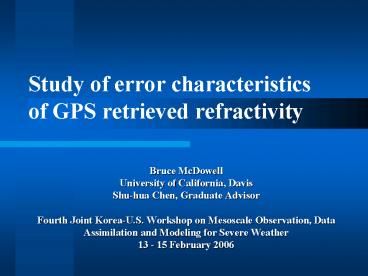Study of error characteristics of GPS retrieved refractivity - PowerPoint PPT Presentation
1 / 13
Title:
Study of error characteristics of GPS retrieved refractivity
Description:
Fourth Joint Korea-U.S. Workshop on Mesoscale Observation, Data ... only from the assumption of spherical symmetry. ... July 7, 2004. January 31, ... – PowerPoint PPT presentation
Number of Views:32
Avg rating:3.0/5.0
Title: Study of error characteristics of GPS retrieved refractivity
1
Study of error characteristics of GPS retrieved
refractivity
- Bruce McDowell
- University of California, Davis
- Shu-hua Chen, Graduate Advisor
- Fourth Joint Korea-U.S. Workshop on Mesoscale
Observation, Data Assimilation and Modeling for
Severe Weather 13 - 15 February 2006
2
Introduction
- COSMIC will launch six low earth orbiting (LEO)
satellites in March 2006. - LEOs used in conjuction with GPS satellites will
provide a source of weather observations that can
be potentially used for global weather
forecasting and long-term climate study. - This simulation study is designed to investigate
differences in average error characteristics of
retrieved local refractivity - Errors arising only from the assumption of
spherical symmetry. - Study area is centered on the lee side of the
Rocky Mountains where large refractivity
disturbances can occur. - Eight cases, four in winter and four in summer,
were used to study errors of retrieved local
refractivity. - In each season, two cases included storms and two
had relatively calm weather.
3
Model Setup
- MM5 Model Code
- 3D Simulation
- Domain 3600 km x 4800 km
- ?x 20 km
- Vertical grid interval stretched
- Mix Phase Moisture Scheme
- Center of Domain on East Side of Rocky Mountains
- COSPAR International Reference Atmosphere (CIRA)
outside of MM5 domain - Ray-tracing Code (Zou et al. ,1999)
4
Computation of Refractivity Fields
Gridded atmospheric refractivity fields are
computed from the model gridded pressure,
temperature and water vapor pressure using the
relation
Rays that define an occultation were assumed to
be in the same plane (i.e., occultation plane)
with all tangent points vertically aligned every
300 m above the occultation point.
N Total Retractivity P pressure (hPa) T
temperature (K) e water vapor pressure (hPa) c1
77.6 K/hPa) c2 3.73 x 105 K2/hPa)
5
Experiment
- Eight cases
- Summer Four
- Winter Four
- Four storms
- Summer Two
- Winter Two
- MM5 model run was 24 hours to simulate a
non-homogenous atmosphere. - Integration of ray paths were performed through
six occultation planes.
6
Experiment
Domain with terrain height. Occultation planes
for every 60 degrees shown at the occultation
point in the center of the domain at 38N 105W.
A schematic diagram for an ideal atmosphere
7
Results
January 31, 1998
July 7, 2004
MM5 24-h simulated total refractivity at 3 km for
2 days with storms Contour Interval 200 lt N lt 250
8
Results
January 31, 1998
July 7, 2004
MM5 24-h simulated total refractivity at 6 km for
2 days with storms Contour Interval 130 lt N lt 160
9
Results
MM5 24-h simulated vertical cross sections of
water vapor mixing ratio (g kg-1) 0-10 km from
west to east for (a) January 31, 1998 (storm) and
(b) February 15, 2004 (no storm).
10
Results
(b)
(a)
Errors (differences) of retrieved local
refractivity from that computed from ideal
atmospheres for six occultation planes for (a)
summer (storms) (b) summer (calm) (c) winter
(storms) (d) winter (calm)
(d)
(c)
11
Results
Averaged errors of the retrieved local
refractivity from six occultation planes during
- winter storms (black- solid line) - winter
calm periods (black-dashed line) - summer storms
(gray-solid line) - summer calm period
(gray-dashed line).
12
Summary
- Errors in retrieved refractivity can reach 10
units or more in the lower troposphere under the
assumption of spherical symmetry. The error
decreases with height linearly until about 3 km,
then fluctuates dramatically from 3 km to 7 km. - Local maximum errors in locations of strong
refractivity gradients can reach 5 units or more
in the upper troposphere. - Averaged retrieved error can underestimate true
refractivity between 3 to 5 km in winter and 3 to
7 km in summer. Maximum errors in summer
occurred higher in the troposphere than in winter
for both storm and calm conditions. - Future work Investigate apparent differences in
height of local maximum error between summer and
winter.
13
Acknowledgements
- Shuhua Chen, Assistant Professor of Meteorology
and Assistant Meteorologist, University of
California at Davis - Elcin Tan, Graduate Student, Atmospheric Science
Program, University of California at Davis































